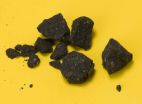(Press-News.org) Durham, NC — Deep in the scrublands of Keoladeo National Park in northwest India, one thing was hard for biologist Jessica Yorzinski to ignore: It wasn't the heat. It wasn't the jackals. It was the squawks of peacocks in the throes of passion.
From behind the trees in the distance, she could hear a loud two-part whoop, the distinctive call that male peacocks make right before mating.
During the peacock courtship dance, a male announces that he's ready to make his move by dashing towards the object of his affection and emitting a singular squawk before mounting his mate.
"Peacocks have a number of different courtship calls, but this is the only one specifically associated with the moment before copulation, a time when the female is finally right in front of the male. It's called the hoot-dash display," said Duke University researcher Jessica Yorzinski.
The amorous peacock's signature hoot poses a puzzle for scientists.
For one, he's already got the girl.
"By that point she's already right there, checking him out. You'd think that he might not need another signal at such a late stage in the courtship process," Yorzinski said.
What's more, the calls could alert potential predators that an easy meal is near. Wild peacocks make quick snacks for jackals, tigers and hawks in their native habitat in South Asia.
"In a sense, they're advertizing that they're distracted and vulnerable. It would be wise for a predator to capitalize on that," Yorzinski said.
Intrigued, Yorzinski recorded the loud carrying-on of males in mid-conquest. Then she played the calls to free-ranging females in India and videotaped their reactions.
At each site, a loudspeaker played copulation calls on one day and silent controls on another day.
VIDEO:
A male peacock demonstrates the "hoot-dash display. "
Click here for more information.
The result: the recorded love sounds made by amorous peacocks in the throes of passion drew eavesdropping females from afar. Females approached and spent more time near speakers that were playing hoots compared to silent controls.
To make sure the birds weren't simply drawn to any noise, Yorzinski repeated a similar experiment with captive birds in an outdoor enclosure at Duke University. There, a speaker played two different sounds: peacock copulation calls, or crow caws.
The results matched what she found in the wild. Captive females paid little attention to the speakers when crow caws were playing, but when the love whoops were played, the females moved toward the source of sound and spent more time near the speaker.
"Why they're attracted to these calls and what it tells them — these are still open questions," Yorzinski said.
Announcing the fact that he's getting a girl could help a male attract additional mates, she explained.
Studies in other species have shown that females flock towards popular males. "It's like someone's already vouched for him. If he's good enough for one girl, then he might be good enough for another girl, too."
That dating boost could make up for the risks involved in disclosing his whereabouts to potential predators, especially in the birds' native habitat in South Asia where dense trees and grasses make strutting males hard for females to spot.
If distant females are drawn to the love calls made by mating males, what's less clear is what keeps males from boosting their call rate to give the impression that they're more successful than they actually are.
"One of the biggest unanswered questions is why males don't fake it," Yorzinski said. "I've heard males making false calls when there's no mate in sight, so there definitely is some level of cheating going on. Figuring out why they don't do it more often would be the key."
INFORMATION:
The study will appear in the January print issue of the journal Behaviour, and is available online at http://booksandjournals.brillonline.com/content/10.1163/1568539x-00003037.
CITATION: Yorzinski, J. and K. Anoop (2013). "Peacock copulation calls attract distant females." Behaviour DOI:10.1163/1568539X-00003037.
The National Evolutionary Synthesis Center (NESCent) is a nonprofit science center dedicated to cross-disciplinary research in evolution. Funded by the National Science Foundation, NESCent is jointly operated by Duke University, The University of North Carolina at Chapel Hill, and North Carolina State University. For more information about research and training opportunities at NESCent, visit www.nescent.org.
Peacock love songs lure eavesdropping females from afar
2012-12-21
ELSE PRESS RELEASES FROM THIS DATE:
Not all gamers are low scorers on friendships, relationships
2012-12-21
UNIVERSITY PARK, Pa. -- Not all video game players are destined for lives filled with failing relationships and dwindling friendships, according to Penn State researchers, who say that a lot depends on the role of the game-playing activity in the gamer's life.
"There's a common stereotype that if you play video games, then you are a loner," said Benjamin Hickerson, assistant professor of recreation, parks and tourism management. "But it may have more to do with how a person is involved in gaming that determines how their social support is affected."
In a study of people ...
Steering stem cells to become 2 different building blocks for new blood vessels
2012-12-21
Growing new blood vessels in the lab is a tough challenge, but a Johns Hopkins engineering team has solved a major stumbling block: how to prod stem cells to become two different types of tissue that are needed to build tiny networks of veins and arteries.
The team's solution is detailed in an article appearing in the January 2013 print edition of the journal Cardiovascular Research. The article also was published recently in the journal's online edition. The work is important because networks of new blood vessels, assembled in the lab for transplanting into patients, ...
2 novel treatments for retinitis pigmentosa move closer to clinical trials
2012-12-21
New York, NY (December 20, 2012) — Two recent experimental treatments — one involving skin-derived induced pluripotent stem (iPS) cell grafts, the other gene therapy — have been shown to produce long-term improvement in visual function in mouse models of retinitis pigmentosa (RP), according to the Columbia University Medical Center (CUMC) scientists who led the studies. At present, there is no cure for RP, the most common form of inherited blindness.
"While these therapies still need to be refined, the results are highly encouraging," said Stephen H. Tsang, MD, PhD, associate ...
NASA sees Cyclone Evan blown apart by wind shear
2012-12-21
Cyclone Evan is no more than a remnant low pressure area in the South Pacific Ocean now. NOAA's GOES-15 satellite captured an image of the remnants from its fixed orbit in space on Dec. 20 that showed strong wind shear had basically blown the storm apart.
The last official bulletin by the Joint Typhoon Warning Center was issued on Dec. 19 at 2100 UTC (4 p.m. EST/U.S. or 12:56 a.m. Fiji local time on Dec. 20). At that time, Evan's maximum sustained winds were still near 35 knots (40 mph/64.8 kph) and it had transitioned into an extra-tropical storm. It was located 400 ...
Eighth Landsat satellite arrives at launch site
2012-12-21
An oversized semi-trailer truck carrying NASA's Landsat Data Continuity Mission (LDCM) has arrived at its launch site at Vandenberg Air Force Base in California in preparation for launch. This NASA and U.S. Geological Survey mission will continue a 40-year record of measuring change on the planet from space.
LDCM is the eighth satellite in the Landsat series, which began in 1972. It will extend and expand global land observations that are critical in many sectors, including energy and water management, forest monitoring, human and environmental health, urban planning, ...
Protein kinase Akt identified as arbiter of cancer stem cell fate
2012-12-21
PHILADELPHIA — The protein kinase Akt is a key regulator of cell growth, proliferation, metabolism, survival, and death. New work on Akt's role in cancer stem cell biology from the lab of senior author Honglin Zhou, MD, PhD and Weihua Li, co-first author, both from the Center for Resuscitation Sciences, Department of Emergency Medicine, Perelman School of Medicine, University of Pennsylvania, and Xiaowei Xu, Department of Pathology and Laboratory Medicine, appears in Molecular Cell. The findings were also highlighted in Nature and Science reviews.
This new research shows ...
Discovery of Africa moth species important for agriculture, controlling invasive plants
2012-12-21
GAINESVILLE, Fla. — In the rain forests of the Congo, where mammals and birds are hunted to near-extinction, an impenetrable sound of buzzing insects blankets the atmosphere.
Because it is a fairly inaccessible region with political unrest, much of the Congo's insect biodiversity remains largely undiscovered. In a new monographic book published this week in Zootaxa, researchers at the University of Florida and the Royal Museum of Central Africa in Belgium provide insect biodiversity information for this area in Central Africa that increasingly undergoes habitat destruction. ...
U of T Researchers uncover major source of evolutionary differences among species
2012-12-21
University of Toronto Faculty of Medicine researchers have uncovered a genetic basis for fundamental differences between humans and other vertebrates that could also help explain why humans are susceptible to diseases not found in other species.
Scientists have wondered why vertebrate species, which look and behave very differently from one another, nevertheless share very similar repertoires of genes. For example, despite obvious physical differences, humans and chimpanzees share a nearly identical set of genes.
The team sequenced and compared the composition of hundreds ...
New meteorite suggests that asteroid surfaces more complex than previously thought
2012-12-21
Meteorites that had fallen from an asteroid impact that lit up the skies over California and Nevada in April are showing scientists just how complex an asteroid surface can be. A new study published in Science this week by an international team of researchers describes the speedy recovery of the meteorites and reports that this space rock is an unusual example from a rare group known as carbonaceous chondrites, which contain some of the oldest material in the solar system. The study of these meteorites and others like them could hold answers to unsolved mysteries about ...
Gift misgivings? Trust your gut
2012-12-21
CHESTNUT HILL, MA (Dec. 20, 2012) – The clock is ticking and you still haven't decided what to get that special someone in your life for the holidays. When it comes to those last-minute gift-buying decisions for family and close friends, intuition may be the best way to think your way through to that perfect gift.
When faced with tough decisions, some people like to "trust their gut" and go with their intuition. Others prefer to take an analytical approach.
Boston College Professor Michael G. Pratt, an expert in organizational psychology, says new research shows intuition ...




